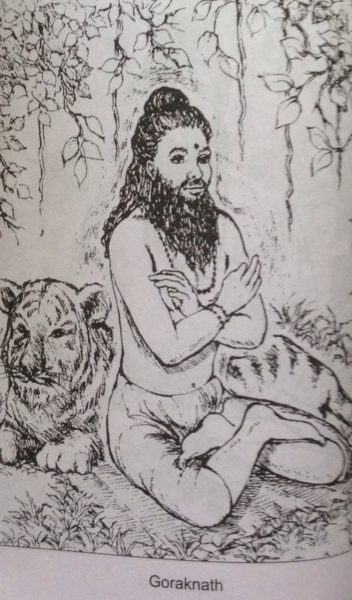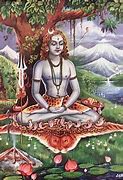
Hello Dear Tweeples!
It’s Siddhars time of the week! Last week I shared story of Guru (Machamuni or Yogi Matsyendranath), this week I bring you information on his Shishya.
#Thread on Gorakanathar Siddhar.
@LostTemple7
It’s Siddhars time of the week! Last week I shared story of Guru (Machamuni or Yogi Matsyendranath), this week I bring you information on his Shishya.
#Thread on Gorakanathar Siddhar.
@LostTemple7

His origin story is interesting, though I couldn’t verify it’s authenticity, so not sharing the story here. He’s shishya of Machamuni Siddhar and also learnt from Agasthiya Siddhar.
@HelloNNewman @RajiIndustani @Kishoreciyer1
@HelloNNewman @RajiIndustani @Kishoreciyer1
Unlike other Siddhars, he is depicted as either with a Tiger or seated & wearing Tiger skin. While I couldn’t find any explanation for this. My interpretation is as follows:
Tiger is a predator that lurks around and attacks unexpectedly.
Tiger is a predator that lurks around and attacks unexpectedly.

Our 5 indriyas and 5 vikitis also similar to Tiger, they lurk around and attacks our thoughts when we’re least expecting. Gorakkar is said to have mastered these aspects, thus to denote this, he shown with Tiger.
@Itishree001 @VarierSangitha @jananisampath
@Itishree001 @VarierSangitha @jananisampath
Gorakanathar or Gorakshnath (as he’s known in the Nath Sampraday) is celebrated Guru in both Northern and Southern part of India. He’s one of the NavNath in Nath Sampraday and also 18 Siddhars of Tamil tradition. During his life, he’s travelled Indian subcontinent extensively +
+ and has influenced the Spiritual growth at that time.
Here I’m naming a well-known place in Northern India that is influenced by Gorakanathar. The famous Gorakhpur in UP and Gorakhnath Math – to which current UP CM (@myogiadityanath ji) belongs to, +
@RapperPandit
Here I’m naming a well-known place in Northern India that is influenced by Gorakanathar. The famous Gorakhpur in UP and Gorakhnath Math – to which current UP CM (@myogiadityanath ji) belongs to, +
@RapperPandit
+ derives it’s name from Gorkanathar or Gorakshnath.
There’s a district in Nepal named ‘Gorkha’, which also is believed to derive it’s name from Gorakshnath. There is a cave with his paduka (footwear) and an idol of him there.
@Elf_of_Shiva_ @hathyogi31 @harshasherni
There’s a district in Nepal named ‘Gorkha’, which also is believed to derive it’s name from Gorakshnath. There is a cave with his paduka (footwear) and an idol of him there.
@Elf_of_Shiva_ @hathyogi31 @harshasherni
Every year on the day of Baisakh Purnima there is a great celebration in Gorkha at his cave, called Rot Mahotsav. It is said that the festival has been celebrated since last seven hundred years.
@VedicWisdom1 @Dharm_Sthapana @Mahadevangini @Tanvangi17 @rightwingchora
@VedicWisdom1 @Dharm_Sthapana @Mahadevangini @Tanvangi17 @rightwingchora
Similarly, in Southern India, a village by the name Akkarai Village (Sucheentharam Taluk, Kanyakumari Dist) celebrate Gorakkar as their ‘Kula Guru’. They celebrate him by the name ‘Yogeeswarar’. People of this village believe that Gorakkar Samadhi is in Korrandy, Therur and +
+ still conduct pooja there. This is because people of the village saw Gorakkar disappear from the temple when they followed him.
As other Siddhars, Gorakkar also contributed in Siddha medicine, Alchemy, Ascetics. Apart from that he also wrote texts on Hath Yoga,
As other Siddhars, Gorakkar also contributed in Siddha medicine, Alchemy, Ascetics. Apart from that he also wrote texts on Hath Yoga,
instructions to Sadhakas of various stages, documentation of his own experience.
It’s believed that Agasthya Siddhar gave Gorakanathar the duty to safeguard the secrets of Alchemy. Thus, even today, people pursuing Alchemy is advised to pray to Gorakanathar Siddhar in order +
It’s believed that Agasthya Siddhar gave Gorakanathar the duty to safeguard the secrets of Alchemy. Thus, even today, people pursuing Alchemy is advised to pray to Gorakanathar Siddhar in order +
+ to unlock the secrets of Alchemy. Thus, similar to other Siddhars, Gorakanathar wrote in Sandhya Basha. In the below poem, he welcomes and advises Seekers:
மறைத்திட்டே னென்குகையி லனேக சித்தை
மைந்தனே வுன்றன்பேர்ச் சொல்லி வைத்தேன்
துறையதனைக் கண்டுநீ யெடுத்துக் கொள்ளு
+
மறைத்திட்டே னென்குகையி லனேக சித்தை
மைந்தனே வுன்றன்பேர்ச் சொல்லி வைத்தேன்
துறையதனைக் கண்டுநீ யெடுத்துக் கொள்ளு
+
+
சொல்லாதே யொருவருக்கும் தொசந் தோசம்
முறையாக விதையறிந்து நடந்தா யானால்
முனிவர்ளுஞ் சித்தர்களும் புகழு வார்கள்
நிறையாக தெரிந்துகொள் மைந்தா நீயும்
நீடூழி காலம்வரை வாழ்கு வாயே
I have hid many secrets in the cave.
Oh Son, I have signified your name!
Go to your section and take it!+
சொல்லாதே யொருவருக்கும் தொசந் தோசம்
முறையாக விதையறிந்து நடந்தா யானால்
முனிவர்ளுஞ் சித்தர்களும் புகழு வார்கள்
நிறையாக தெரிந்துகொள் மைந்தா நீயும்
நீடூழி காலம்வரை வாழ்கு வாயே
I have hid many secrets in the cave.
Oh Son, I have signified your name!
Go to your section and take it!+
+ Do not speak of it, for it isn’t appropriate.
If you follow the proper instructions,
The Sages and Siddhas shall shower praises.
Understand completely, oh my son!
May you live for eternity!
@VedicCulture__ @lalitha_jr @krithikasivasw @Krishna_Priiya
If you follow the proper instructions,
The Sages and Siddhas shall shower praises.
Understand completely, oh my son!
May you live for eternity!
@VedicCulture__ @lalitha_jr @krithikasivasw @Krishna_Priiya
There are many stories that talks about Gorakkanathar’s Guru Bhakti, it’s said that he used to follow vigorously and extensively, every instruction from his guru Matsyendranatha Siddhar. You can read about one such story in below link:
isha.sadhguru.org/in/en/wisdom/a…
@NandiniVenkate3
isha.sadhguru.org/in/en/wisdom/a…
@NandiniVenkate3
Below is the list of Gorakkar Siddhar’s works:
korakkar chandira regai (கோரக்கர் சந்திரரேகை)
korakkar namanaasathiravukol (கோரக்கர் நமநாசத் திறவுகோல்)
korakkar ravimegalai (கோரக்கர் ரவிமேகலை)
korakkar muththaaram (கோரக்கர் முத்தாரம்)
korakkar malai vagadam (கோரக்கர் மலை வாகடம்)
korakkar chandira regai (கோரக்கர் சந்திரரேகை)
korakkar namanaasathiravukol (கோரக்கர் நமநாசத் திறவுகோல்)
korakkar ravimegalai (கோரக்கர் ரவிமேகலை)
korakkar muththaaram (கோரக்கர் முத்தாரம்)
korakkar malai vagadam (கோரக்கர் மலை வாகடம்)
korakkar karppam (கோரக்கர் கற்பம்)
korakkar muthineri (கோரக்கர் முத்திநெறி)
korakkar attakarmam (கோரக்கர் அட்டகர்மம்)
korakkar soothiram (கோரக்கர் சூத்திரம்)
korakkar vagara soothiram (கோரக்கர் வகார சூத்திரம்)
korakkar thandagam (கோரக்கர் தண்டகம்)
@desi_thug1 @DivineElement
korakkar muthineri (கோரக்கர் முத்திநெறி)
korakkar attakarmam (கோரக்கர் அட்டகர்மம்)
korakkar soothiram (கோரக்கர் சூத்திரம்)
korakkar vagara soothiram (கோரக்கர் வகார சூத்திரம்)
korakkar thandagam (கோரக்கர் தண்டகம்)
@desi_thug1 @DivineElement
korakkar karppa soothiram (கோரக்கர் கற்ப சூத்திரம்)
korakkar bhrama gnanam (கோரக்கர் பிரம்மஞானம்)
Though in Tamil tradition, it’s believed that Gorakkar Siddhar attained mukti and his Jeeva-samadhi is believed to be in Vada Poigainallur, Nagapattinam.
@sambhashan_in
korakkar bhrama gnanam (கோரக்கர் பிரம்மஞானம்)
Though in Tamil tradition, it’s believed that Gorakkar Siddhar attained mukti and his Jeeva-samadhi is believed to be in Vada Poigainallur, Nagapattinam.
@sambhashan_in

There’s another belief that he’s still observing humankind and from time to time reveals himself to teach people.
There’s so much to talk about Gorakkar Siddhar, however I’ve only included tidbit of information. Hope you enjoyed reading about Gorakanathar or Gorakshnath.
There’s so much to talk about Gorakkar Siddhar, however I’ve only included tidbit of information. Hope you enjoyed reading about Gorakanathar or Gorakshnath.
Till next time, take care and most importantly – Be Happy! ☺️🙏
Content courtesy: anaadifoundation.org & tknsiddha.com
Pic courtesy: Bing
@BesuraTaansane @chittukuruvi4
Content courtesy: anaadifoundation.org & tknsiddha.com
Pic courtesy: Bing
@BesuraTaansane @chittukuruvi4
• • •
Missing some Tweet in this thread? You can try to
force a refresh





